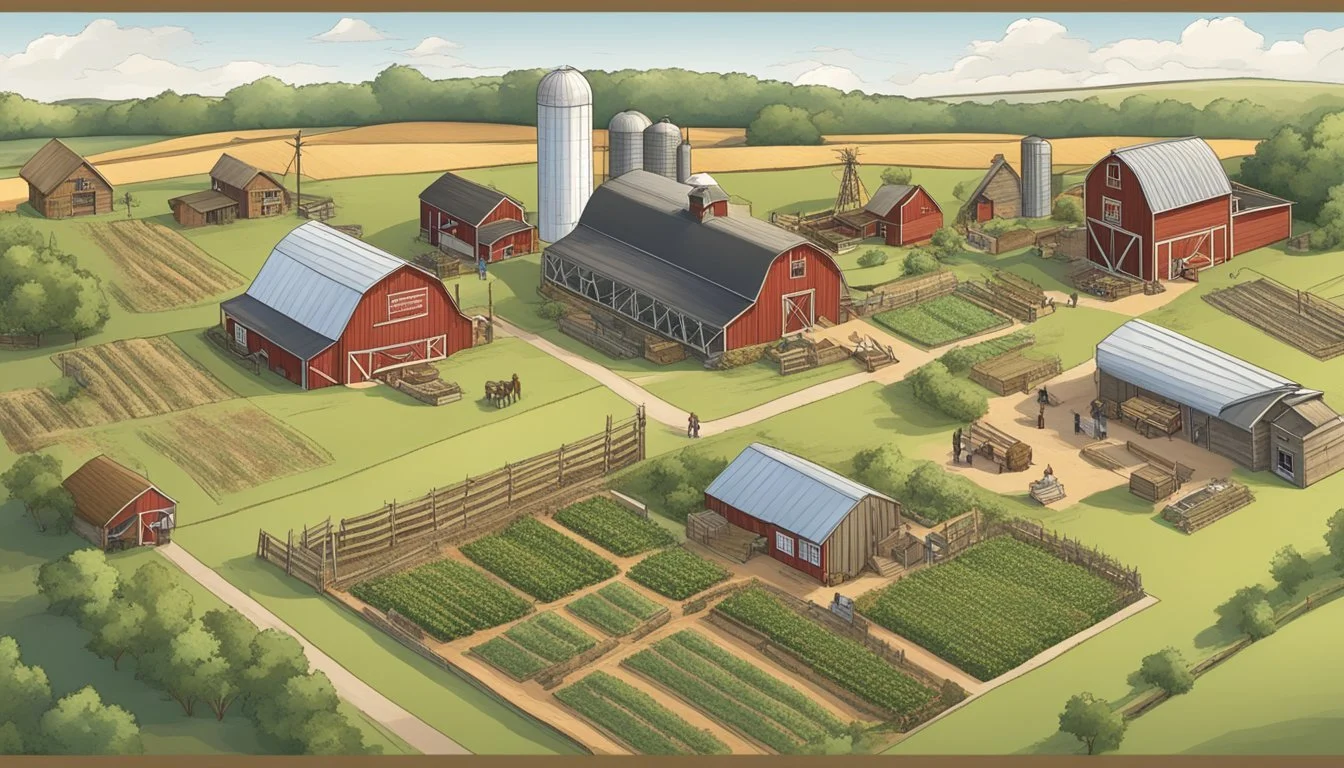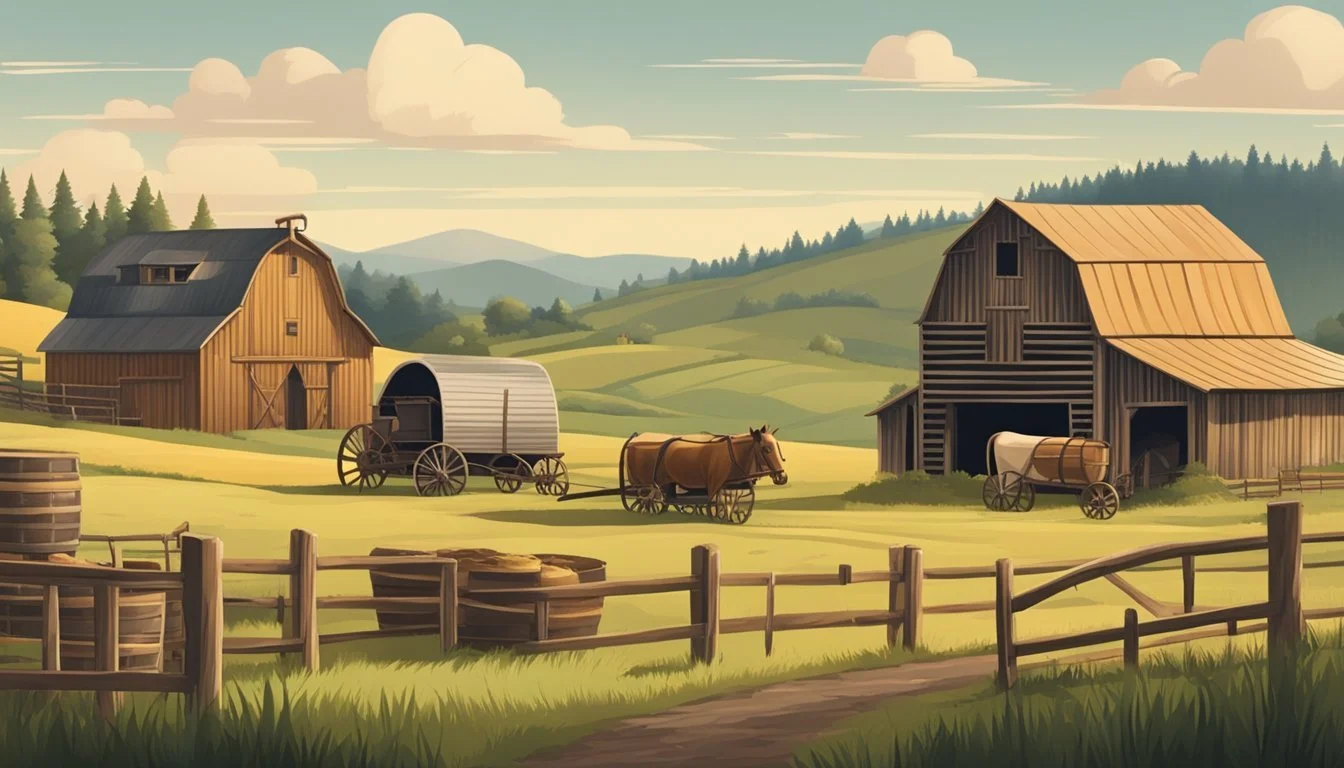Historical Farms and Agricultural Museums in Oklahoma
A Guide to Agrarian Heritage
The state of Oklahoma has a long-standing tradition of agriculture that serves not only as the backbone of its economy but also as a rich canvas of its historical narrative. Museums dedicated to this sector play an essential role in preserving the artifacts and stories of Oklahoma's farming history. They offer visitors a glimpse into the robust agricultural heritage that helped shape the region. Among these institutions, the Farm and Ranch Museum stands out, curated by the Western Oklahoma Historical Society; it is a testament to the state's enduring connection to the land and its agricultural practices.
Agricultural museums in Oklahoma provide an educational resource for those interested in the evolution of farming and ranching in the region. They house collections of early farm tools, machinery, and exhibits on rural life, giving insight into the innovations that have driven Oklahoma's agricultural progress. The Oklahoma Farm and Ranch Museum in Elk City is another notable venue where the history of farming is celebrated. It showcases a variety of exhibits, displaying the state's dedication to agricultural history.
By exploring these museums, visitors and locals alike can understand the importance of agriculture to Oklahoma's development. The preservation of old farmhouses, vintage machinery, and the recreated historical environments found within the Elk City Museum Complex enable guests to immerse themselves in the pioneer spirit that still lives on today. They serve as places of learning and reflection, honoring the toil and triumphs of the state's ancestors and their contributions to agriculture.
Historical Context of Agriculture in Oklahoma
Oklahoma's rich agricultural history is deeply entwined with the cultural narratives and economic developments that have shaped the region. From the extensive farming practices of Native American tribes to the transformation of agriculture in the 20th century, Oklahoma presents a multifaceted panorama of agricultural evolution.
Native American Agriculture and Ranch Life
Before European settlement, indigenous tribes such as the Cherokee, Choctaw, Chickasaw, Seminole, and Creek engaged in sophisticated agricultural practices within Oklahoma's borders. The Cherokee Outlet, also known as the Cherokee Strip, was significant for its role in promoting ranch life, where tribes expertly managed herds and cultivated a variety of crops. Traditional techniques of these early inhabitants laid foundational agricultural principles that persisted through the centuries.
Pioneer Farmers and the Land Run
With the Land Run of 1889, a significant influx of pioneer farmers marked a dramatic shift in Oklahoma's agricultural landscape. Homesteaders swiftly adapted to the land, introducing crops like corn and wheat which became central to Oklahoma's economy. The Oklahoma Historical Society documents how these early settlers prevailed over challenges, profoundly changing the region’s agricultural methods and practices.
Agriculture during the 20th Century
The 20th century brought about significant changes in Oklahoma's agriculture, including mechanization and the introduction of modern farming techniques. These innovations advanced productivity but also contributed to the ecological challenges like the Dust Bowl. From the early 1900s, agricultural emphasis gradually transitioned from sole dependence on crops like cotton to a more diversified portfolio including livestock and wheat, reflecting adaptability and resilience in the face of economic cycles and government policies affecting agriculture.
Key Agricultural Museums in Oklahoma
Oklahoma's landscape is deeply intertwined with its agricultural history, showcased prominently in its museums. Here, visitors can explore a rich tapestry of the state's farming legacy through a variety of exhibits, from the pioneering days to Route 66’s heyday.
Oklahoma History Center
The Oklahoma History Center serves as a custodian of state heritage, with exhibits that honor Oklahoma's agrarian roots. It proudly displays artifacts and interactive displays that narrate the evolution of agriculture across the state.
Museum of the Western Prairie
In Altus, the Museum of the Western Prairie stands as a testament to the resilience of early settlers. It chronicles the challenges and triumphs of farming and ranching in the tough conditions of Western Oklahoma.
Route 66 Museum
Part of the Old Town Museum complex in Elk City, the Route 66 Museum also houses the Farm and Ranch Museum. Visitors embark on a nostalgic journey through the vintage cars and historical artifacts that detail the story of America's most famous highway and its connection to rural communities.
Sod House Museum
The Sod House Museum near Aline protects the only remaining sod house in the state built by a homesteader. The museum not only preserves this unique structure but also educates the public on the ingenuity and determination of the state's early settlers in creating sustainable homes from the very earth.
Living History Sites
Oklahoma offers an immersive glance into the past with various living history sites where visitors can experience the rich narratives of the state's historical farms and museums. These sites showcase re-enactments, original artifacts, and the pioneering spirit that shaped Western Oklahoma.
Cherokee Strip Regional Heritage Center
The Cherokee Strip Regional Heritage Center in Enid stands testament to the indomitable will of settlers who took part in the largest land run in United States history. They bring the past to life with events and educational programs, recreating the experiences of those who rushed to claim land in the Cherokee Strip Land Run of 1893.
Oklahoma Route 66 Museum
The journey along America's most iconic highway is commemorated at the Oklahoma Route 66 Museum in Clinton. Visitors can explore the history of Route 66 through interactive exhibits that highlight the culture, music, and people of the famous roadway that traverses Western Oklahoma.
Old Town Museum Complex
Elk City's Old Town Museum Complex is a celebration of pioneer life. This complex includes the Farm and Ranch Museum, which showcases early farm and ranch life through a vast collection of tools and exhibits. Visitors can explore the beautifully preserved buildings and interact with exhibits that paint a vivid picture of the Oklahoma frontier.
Preservation and Education Efforts
Oklahoma boasts a rich tapestry of historical farms and agricultural museums that actively engage in preservation and education. These initiatives provide the public with a deeper understanding of the state's agricultural heritage and historical significance.
Encyclopedia of Oklahoma History and Culture
The Oklahoma Historical Society maintains the Encyclopedia of Oklahoma History and Culture, a vital resource for preserving the state's history. This publication serves as a repository of Oklahoma's past, supporting educational outreach by providing rich narratives and factual accounts relevant to the state's agricultural history.
Educational Programs and Tours
Several historical farms and museums offer a variety of educational programs and guided tours. These initiatives cater to all ages and facilitate hands-on learning experiences that bring Oklahoma's agricultural past to life. Participants can directly engage with the historical practices that shaped current agricultural methods.
Historical Marker Program
The Historical Marker Program, administered by the Oklahoma Historical Society, plays a significant role in recognizing the state's agricultural sites of historical significance. Through this program, farms and museums showcase historical markers that inform visitors about the legacy and importance of these preserved sites.
Collections and Exhibitions
The historical farms and agricultural museums across Oklahoma boast an impressive array of collections that provide a tangible link to the state's farming past. They house extensive exhibits ranging from pioneer-era farm tools and equipment to an assortment of windmill types, ensuring a comprehensive route through agricultural history.
Farm Tools and Equipment
The museums' collection of farm tools and equipment represents the ingenuity and evolution of agricultural practices. Visitors can explore exhibits showcasing hand-operated plows, sickles, and other implements fundamental to early farming. A particular highlight is the blacksmith shop, where tools were forged and now serve as a testament to the craftsmanship of the era.
Photographs and Documents
Photographs and documents are a window into the past. The museums offer a vast exhibit of historical photographs that depict daily life on the farm, significant agricultural events, and portraits of individuals who shaped the farming community. These images, alongside documents such as land grants, diaries, and letters, are pivotal in understanding Oklahoma's rich farming heritage.
Costumes and Textiles
The museum extends its exhibits to include costumes and textiles, illustrating the day-to-day wear of Oklahoma farmers through the ages. This section of the collection offers a sensory experience with garments ranging from durable workwear to homemade textiles, each piece echoing the lifestyle and fashion of the time.
Cultural and Community Contributions
Oklahoma's agricultural museums play a vital role in preserving the state's rich cultural heritage and fostering community spirit. They serve as hubs for education and engagement, providing a space for people to connect with history and with each other.
Oklahoma Agricultural Museums Network
The network of agricultural museums across Oklahoma is instrumental in safeguarding the state's farming legacy. These institutions, like the Farm and Ranch Museum, offer an expansive repository of antique farming tools and technologies that bring to life the ingenuity and dedication of early Oklahoman farmers. The collective efforts of these museums ensure that Oklahoma's cultural heritage in agriculture is not only remembered but also celebrated.
Volunteer Programs and Membership
Many agricultural museums in Oklahoma thrive through the support of volunteers and members. Volunteer programs often involve enthusiasts from all walks of life who contribute to the daily operations, from guiding tours to maintaining exhibits. Membership to museums or associations, such as the Western Oklahoma Historical Society, provides individuals the chance to support these cultural institutions while receiving benefits like special tours and event invites, thereby strengthening ties within the community.
Special Events and Community Engagement
Agricultural museums frequently host events aimed at fostering community engagement and education. These events range from historical reenactments to seasonal festivals, offering immersive experiences that highlight the agricultural past. For example, celebrations of harvest and exhibitions on farming methods connect the community with their history, while also providing a platform for local artisans and vendors to contribute economically through the museum's store. Such events serve as a nexus for cultural and community contributions, enhancing the visibility and viability of these living history institutions.
Specialized Agricultural Museums and Historic Sites
Oklahoma offers a rich tapestry of specialized agricultural museums and historic sites that pay homage to the state's deep-rooted connection to farming and ranching traditions. From the dedicated museums celebrating the challenging life of early ranchers to archaeological centers providing insights into ancient agricultural practices, these institutions preserve Oklahoma's diverse historical legacy.
Farm and Ranch Museum
The Farm and Ranch Museum, operated by the Western Oklahoma Historical Society, showcases the evolution of farming techniques and equipment through meticulously preserved artifacts and exhibits. Visitors can learn about the ingenuity and resilience of farmers who have shaped the region's agricultural history.
Chisholm Trail Museum
Chisholm Trail Museum, steeped in the history of the famous cattle trail, offers an in-depth look at the lives of cowboys and the pivotal role of cattle drives in the expansion of America. Alongside historic homes, the museum features interactive displays that illustrate the challenges and triumphs of the trail-riding ranchers of the Old West.
Spiro Mounds Archaeological Center
The Spiro Mounds Archaeological Center delves into the fascinating world of the Spiro people, an indigenous group known for their complex society and agricultural practices. The site offers not just a glimpse into prehistoric mounds but also educates visitors on the region's thousand-year-old agrarian history as it highlights the intersection of nature, culture, and archaeology.







